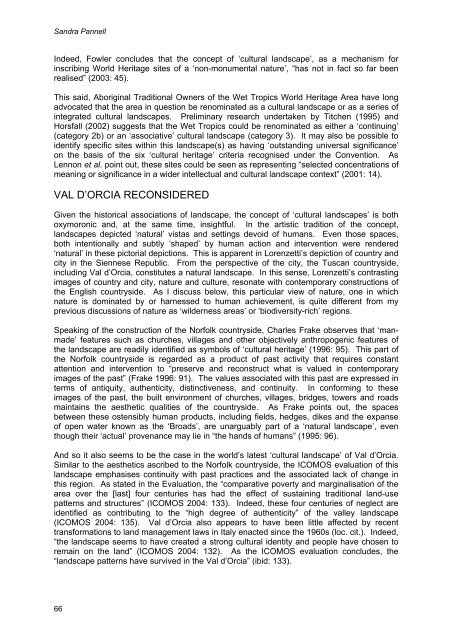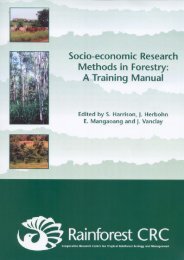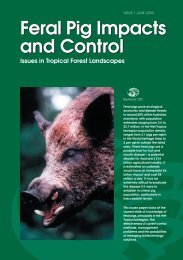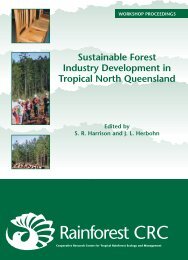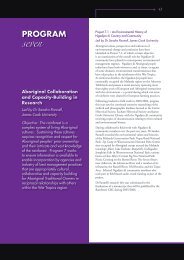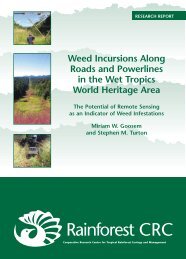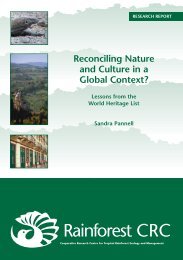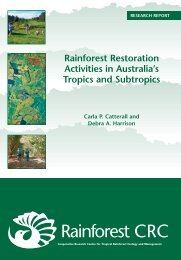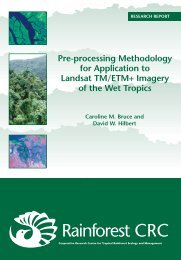Reconciling Nature and Culture in a Global Context? - Rainforest ...
Reconciling Nature and Culture in a Global Context? - Rainforest ...
Reconciling Nature and Culture in a Global Context? - Rainforest ...
Create successful ePaper yourself
Turn your PDF publications into a flip-book with our unique Google optimized e-Paper software.
S<strong>and</strong>ra PannellIndeed, Fowler concludes that the concept of ‘cultural l<strong>and</strong>scape’, as a mechanism for<strong>in</strong>scrib<strong>in</strong>g World Heritage sites of a ‘non-monumental nature’, “has not <strong>in</strong> fact so far beenrealised” (2003: 45).This said, Aborig<strong>in</strong>al Traditional Owners of the Wet Tropics World Heritage Area have longadvocated that the area <strong>in</strong> question be renom<strong>in</strong>ated as a cultural l<strong>and</strong>scape or as a series of<strong>in</strong>tegrated cultural l<strong>and</strong>scapes. Prelim<strong>in</strong>ary research undertaken by Titchen (1995) <strong>and</strong>Horsfall (2002) suggests that the Wet Tropics could be renom<strong>in</strong>ated as either a ‘cont<strong>in</strong>u<strong>in</strong>g’(category 2b) or an ‘associative’ cultural l<strong>and</strong>scape (category 3). It may also be possible toidentify specific sites with<strong>in</strong> this l<strong>and</strong>scape(s) as hav<strong>in</strong>g ‘outst<strong>and</strong><strong>in</strong>g universal significance’on the basis of the six ‘cultural heritage’ criteria recognised under the Convention. AsLennon et al. po<strong>in</strong>t out, these sites could be seen as represent<strong>in</strong>g “selected concentrations ofmean<strong>in</strong>g or significance <strong>in</strong> a wider <strong>in</strong>tellectual <strong>and</strong> cultural l<strong>and</strong>scape context” (2001: 14).VAL D’ORCIA RECONSIDEREDGiven the historical associations of l<strong>and</strong>scape, the concept of ‘cultural l<strong>and</strong>scapes’ is bothoxymoronic <strong>and</strong>, at the same time, <strong>in</strong>sightful. In the artistic tradition of the concept,l<strong>and</strong>scapes depicted ‘natural’ vistas <strong>and</strong> sett<strong>in</strong>gs devoid of humans. Even those spaces,both <strong>in</strong>tentionally <strong>and</strong> subtly ‘shaped’ by human action <strong>and</strong> <strong>in</strong>tervention were rendered‘natural’ <strong>in</strong> these pictorial depictions. This is apparent <strong>in</strong> Lorenzetti’s depiction of country <strong>and</strong>city <strong>in</strong> the Siennese Republic. From the perspective of the city, the Tuscan countryside,<strong>in</strong>clud<strong>in</strong>g Val d’Orcia, constitutes a natural l<strong>and</strong>scape. In this sense, Lorenzetti’s contrast<strong>in</strong>gimages of country <strong>and</strong> city, nature <strong>and</strong> culture, resonate with contemporary constructions ofthe English countryside. As I discuss below, this particular view of nature, one <strong>in</strong> whichnature is dom<strong>in</strong>ated by or harnessed to human achievement, is quite different from myprevious discussions of nature as ‘wilderness areas’ or ‘biodiversity-rich’ regions.Speak<strong>in</strong>g of the construction of the Norfolk countryside, Charles Frake observes that ‘manmade’features such as churches, villages <strong>and</strong> other objectively anthropogenic features ofthe l<strong>and</strong>scape are readily identified as symbols of ‘cultural heritage’ (1996: 95). This part ofthe Norfolk countryside is regarded as a product of past activity that requires constantattention <strong>and</strong> <strong>in</strong>tervention to “preserve <strong>and</strong> reconstruct what is valued <strong>in</strong> contemporaryimages of the past” (Frake 1996: 91). The values associated with this past are expressed <strong>in</strong>terms of antiquity, authenticity, dist<strong>in</strong>ctiveness, <strong>and</strong> cont<strong>in</strong>uity. In conform<strong>in</strong>g to theseimages of the past, the built environment of churches, villages, bridges, towers <strong>and</strong> roadsma<strong>in</strong>ta<strong>in</strong>s the aesthetic qualities of the countryside. As Frake po<strong>in</strong>ts out, the spacesbetween these ostensibly human products, <strong>in</strong>clud<strong>in</strong>g fields, hedges, dikes <strong>and</strong> the expanseof open water known as the ‘Broads’, are unarguably part of a ‘natural l<strong>and</strong>scape’, eventhough their ‘actual’ provenance may lie <strong>in</strong> “the h<strong>and</strong>s of humans” (1995: 96).And so it also seems to be the case <strong>in</strong> the world’s latest ‘cultural l<strong>and</strong>scape’ of Val d’Orcia.Similar to the aesthetics ascribed to the Norfolk countryside, the ICOMOS evaluation of thisl<strong>and</strong>scape emphasises cont<strong>in</strong>uity with past practices <strong>and</strong> the associated lack of change <strong>in</strong>this region. As stated <strong>in</strong> the Evaluation, the “comparative poverty <strong>and</strong> marg<strong>in</strong>alisation of thearea over the [last] four centuries has had the effect of susta<strong>in</strong><strong>in</strong>g traditional l<strong>and</strong>-usepatterns <strong>and</strong> structures” (ICOMOS 2004: 133). Indeed, these four centuries of neglect areidentified as contribut<strong>in</strong>g to the “high degree of authenticity” of the valley l<strong>and</strong>scape(ICOMOS 2004: 135). Val d’Orcia also appears to have been little affected by recenttransformations to l<strong>and</strong> management laws <strong>in</strong> Italy enacted s<strong>in</strong>ce the 1960s (loc. cit.). Indeed,“the l<strong>and</strong>scape seems to have created a strong cultural identity <strong>and</strong> people have chosen torema<strong>in</strong> on the l<strong>and</strong>” (ICOMOS 2004: 132). As the ICOMOS evaluation concludes, the“l<strong>and</strong>scape patterns have survived <strong>in</strong> the Val d’Orcia” (ibid: 133).66


